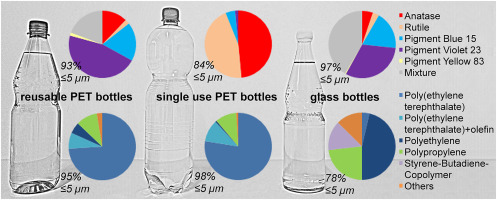Water Research ( IF 11.4 ) Pub Date : 2018-05-16 , DOI: 10.1016/j.watres.2018.05.027 Barbara E. Oßmann , George Sarau , Heinrich Holtmannspötter , Monika Pischetsrieder , Silke H. Christiansen , Wilhelm Dicke

|
Up to now, only a few studies about microparticle contamination of bottled mineral water have been published. The smallest analysed particle size was 5 μm. However, due to toxicological reasons, especially microparticles smaller than 1.5 μm are critically discussed. Therefore, in the present study, 32 samples of bottled mineral water were investigated for contamination by microplastics, pigment and additive particles. Due to the application of aluminium coated polycarbonate membrane filters and micro-Raman spectroscopy, a lowest analysed particle size of 1 μm was achieved.
Microplastics were found in water from all bottle types: in single use and reusable bottles made of poly(ethylene terephthalate) (PET) as well as in glass bottles. The amount of microplastics in mineral water varied from 2649 ± 2857 per litre in single use PET bottles up to 6292 ± 10521 per litre in glass bottles. While in plastic bottles, the predominant polymer type was PET; in glass bottles various polymers such as polyethylene or styrene-butadiene-copolymer were found. Hence, besides the packaging itself, other contamination sources have to be considered.
Pigment particles were detected in high amounts in reusable, paper labelled bottles (195047 ± 330810 pigment particles per litre in glass and 23594 ± 25518 pigment particles per litre in reusable paper labelled PET bottles). Pigment types found in water samples were the same as used for label printing, indicating the bottle cleaning process as possible contamination route.
Furthermore, on average 708 ± 1024 particles per litre of the additive Tris(2,4-di-tert-butylphenyl)phosphite were found in reusable PET bottles. This additive might be leached out from the bottle material itself.
Over 90% of the detected microplastics and pigment particles were smaller than 5 μm and thus not covered by previous studies. In summary, this is the first study reporting about microplastics, pigment and additive particles found in bottled mineral water samples with a smallest analysed particle size of 1 μm.
中文翻译:

瓶装矿泉水中的小型微塑料和色素颗粒
迄今为止,关于瓶装矿泉水的微粒污染的研究很少。最小的分析粒径为5μm。但是,由于毒理学原因,特别是对小于1.5μm的微粒进行了严格的讨论。因此,在本研究中,对32个瓶装矿泉水样品进行了调查,以了解其是否被微塑料,颜料和添加剂颗粒污染。由于应用了铝涂层的聚碳酸酯膜过滤器和显微拉曼光谱技术,因此获得了最低的1μm分析粒度。
在所有类型的瓶子的水中都发现了微塑料:一次性使用和可重复使用的聚对苯二甲酸乙二醇酯(PET)制成的瓶子以及玻璃瓶。矿泉水中的微量塑料含量从单次使用PET瓶中的每升2649±2857到玻璃瓶中每升的6292±10521。在塑料瓶中,主要的聚合物类型是PET。在玻璃瓶中,发现了各种聚合物,例如聚乙烯或苯乙烯-丁二烯-共聚物。因此,除了包装本身之外,还必须考虑其他污染源。
在可重复使用的纸质标签瓶中检测到大量颜料颗粒(玻璃中每升195047±330810颜料颗粒每升,可重复使用纸质标签PET瓶中每升23594±25518颜料颗粒)。水样品中发现的颜料类型与标签打印所使用的颜料类型相同,表明瓶子清洁过程是可能的污染途径。
此外,在可重复使用的PET瓶中,平均每升添加剂Tris(2,4-di-叔丁基苯基)亚磷酸酯平均含有708±1024个颗粒。该添加剂可能从瓶子材料本身中浸出。
超过90%的检测到的微塑料和颜料颗粒小于5μm,因此以前的研究未涵盖。总而言之,这是第一项报道关于瓶装矿泉水样品中发现的最小粒径为1μm的微塑料,颜料和添加剂颗粒的研究。











































 京公网安备 11010802027423号
京公网安备 11010802027423号